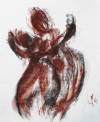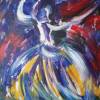















Colour of dance
Dance, movement, gestures, energy and rhythm make Sen’s brush play on the canvas creating a deep emotional impact, thanks to colours.
We find in these paintings a strong physical sensuality mixed with deep grace and harmony. This expressive freedom is like the mirror of the soul, a guideline of Sen’s Gesturism Art. The viewer is emotionally pulled into this harmonic vortex.
Similar is the vibrancy of the other dances Sen has painted, Salsa, Tango, Flamenco. From all these paintings we perceive a strong vitality, resulting from Sen’s analysis of the meaning of dance that different countries of the world swirl to.
The Impressionists painted light and atmospheres; like Degas, Sen uses the grace and beauty of dance to paint its movement through harmony. “Colour of Dance” supports the movement and creates life like in Waltz where the dancers almost melt into a single figure dragged by their passion.
Alberto Moioli, Member AICA. Editorial Director, Enciclopediad’ArteItaliana, Art Advisor Art Affinity


